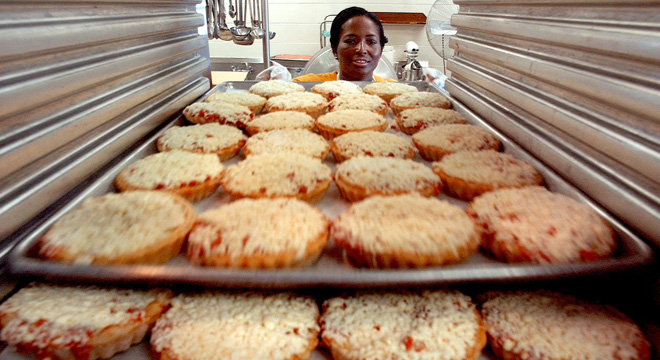Okay, pizza is not actually a vegetable. Delicious, yes. But vegetable? Nope. The scant serving of tomato paste in school lunch pizza does, however, count as one half-cup serving of vegetables, thanks to the final version of the House-Senate agriculture spending bill.
The USDA was hoping to change that, though. Under a proposed rule, a vegetable serving of tomato paste would have to be a whole one half-cup serving, not two tablespoons, as it is now.
But, opponents of the rule argued, that would render a slice of pizza inedible. “It would basically be swimming in tomato sauce,” said Corey Henry, vice president of communications at the American Frozen Food Institute. “No school kid in his right mind would want to eat that.”
Rightfully so. Henry told TPM that tomato paste is a “nutritiously dense” food. “It’s a mischaracterization to say there’s no nutritional value in that slice of pizza,” Henry said, adding that the USDA’s efforts essentially were trying to rid school lunches of pizza.
So let’s accept that tomato paste is a nutritious food. Few would disagree. But tomato paste and pizza sauce are not one and the same. How much tomato paste is in pizza sauce, for instance, TPM asked. It can be up to 50 percent of the sauce, depending on its thickness, Henry said. With roughly two to three tablespoons of sauce on each serving of pizza, that’s about 2 teaspoons of actual tomato paste in each serving. But the current logic is that the added water creates more of the actual vegetable.
And tomato paste is the only fruit or vegetable puree that is credited in this way, USDA spokesman Aaron Lavallee told TPM. The proposed change to tomato paste wasn’t about pizza, specifically, he said. Schools could still serve pizza at lunch, but with more vegetables on the pizza, or more vegetables on the side.
A source at the American Academy of Pediatrics told TPM that it’s disappointing the USDA rules were blocked in the spending bill. While tomato paste itself is not unhealthy, it’s better for kids to get nutrition from actual vegetables, the source said, which is why the USDA proposed the rule in the first place. “Our big concern is that kids are going to eat the slice of pizza and not get the vegetable in their meal,” the source said. While Henry argued in favor of pizza’s nutritional value, he also said kids need to eat more fruits and vegetables across the board. “We very much favor efforts to increase school nutrition,” he said.
The New York Times reports that a total of $5.6 million was spent on lobbying efforts against the school lunch rules. Henry at the American Frozen Food Institute declined to comment how much his organization spent on their efforts. Messages left with Sara Lee, Schwan’s and ConAgra were not immediately returned.
“While it’s unfortunate that some members of Congress continue to put special interests ahead of the health of America’s children, USDA remains committed to practical, science-based standards for school meals,” Lavalle at the USDA told TPM in a statement.
Margo Wootan, director of nutrition policy at the Center for Science in the Public Interest, told TPM that the only reason tomato paste is credited differently than other fruits and vegetables is because pizza makers want it that way. She’s not arguing for a half-cup of pizza sauce on each serving of pizza, but she says “it’s a shame that Congress is more interested in protecting (special interests) than protecting children’s health. … They should be helping USDA serve healthier school meals, not making it harder.”
Lost in the conversation about the USDA’s proposed rules — and the conversation about “pizza as a vegetable” — is that school lunches are healthier than many options kids otherwise have, said Barry Sackin, a coordinator at the Coalition for Sustainable School Meals Programs, an organization that seeks to provide policy information to food service workers. Food companies like Schwan’s and ConAgra have provided limited financial backing to the organization, but Sackin said the contributions are barely a blip on the map compared to any larger lobbying efforts.
Sackin is a school food service veteran who told TPM that the cost of the USDA’s proposed rules — about $7 billion — is what concerns him most. If a child eats lunch at school everyday that class is in session, it’s only 16 percent of their meals.
“School meals are certainly healthier than the public image that they’re given,” Sackins said. “There’s always room for improvement. … Those people who are concerned should take time to visit their school cafeterias.” Most food service directors would welcome the visit, he said.










